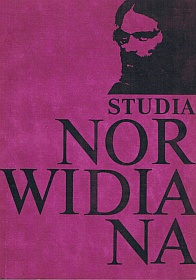Cyprian Norwid as a Graphic Artist
Abstract
Cyprian Norwid is chiefly known as a poet and less well as a painter and graphic artist. His work as an engraver began in the autumn of 1844 in Florence, where he studied for a time at the Academy of Fine Arts. To that period belong two reproductive etchings: Św. Maria Magdalena u stóp Chrystusa (St. Mary Magdalene at the Feet of Jesus), after a painting by Andrea del Sarto, and Grzech Pierworodny (The Original Sin) after Raphael’s fresco in the Vatican Stanzas. In Paris, where Norwid lived until his death, he made (in 1850) two pictures on New Testament themes: an etching called Nie było dla nich miejsca w gospodzie (There Was No Room for Them at the Inn) and a soft-ground Św. Józef z Dzieciątkiem (St. Joseph and Child), both after his own drawings. Before his journey to America (November 1852) the poet etched a multifigural composition called Wskrzeszenie Łazarza (The Resurrection of Lazarus). After returning to Paris in December 1854 he tried to make a living as a graphic artist. He made further works on New Testament themes and the Gospel parables: Modlitwa dziecka (A Child’s Prayer), 1855, Chrystus na krzyżu (Christ on the Cross), 1856, both etched, and Zwiastowanie pasterzom (Annunciation to the Shepherds), 1856, a lithograph. The year 1857 brought an etching known in two versions as Na cmentarzu (In the Graveyard) or Alleluja', it is a symbolic allegorical composition. In the same year Norwid transferred to the lithographic stone, with his own corrections, some rather poor drawings by Artur Bartels, which constitute the sequence Lapigrosz (The Money-grubber). The effect of this undertaking by the Paris publisher Jan Kazimierz Wilczyński was an album entitled Lapigrosz. Szkice obyczajowe (The Money-grubber. Moral Sketches). Brought out in 1858, the album contained fifteen plates comprising almost fifty satirical drawings. Norwid was reluctant to etch or lithograph other people's works. In 1860 he made another exception for Antoni Zaleski, whose drawing was the basis of an etched frontispiece for two long poems by Teofil Lenartowicz, Zachwycenie i Błogosławiona, published in Poznań in the following year. Norwid’s cooperation with the Paris lithographic printing-shop of Saint-Aubin resulted in three lithographs of ambiguous meaning: Echo ruin (Echo of the Ruins), Scherzo and Solo, also known as Melancholia (Melancholy) - all made in 1861. The next three etchings, Męczennik (Martyr), Pythia and Sybilla (Sibyl) were displayed in 1865 at an exhibition in the museum of Nimes. French critics estimated them highly, comparing them to the works of Durer, Leonardo da Vinci and Rembrandt. The poet’s last etching but one. Muzyk niepotrzebny (Musician Not Needed), 1867, a concealed self-portrait, is a bitter reproach to his contemporaries for understanding neither the artist nor his art. His last engraving is Dialog zmarłych (Dialogue of the Dead), 1871, which represents a conversation of Rembrandt and Phidias; it is a graphic parallel to his earlier poetic dialogues of the shades of Napoleon and Caesar, Byron and Raphael.
Norwid can be described as a peintre-graveur, i.e., an engraver who based his works entirely on his own drawings, for reproduction played no major role in his art. In his engravings Norwid seems to have remained indifferent to the important political events that he witnessed. He found his subjects mostly in the New Testament and occasionally in the Antiquity. It is notable that he engraved no portraits or landscapes in the strict sense. He had an inclination to symbolic compositions of hidden, indeterminate meaning, usually with just one or two figures; multifigural scenes are rare.
Norwid’s engravings are a rarity. They were usually printed in a small number of copies and occasionally just once. Only a few prints have come down to us, and the copper plates are lost. Norwid’s graphic art is unique and does not fit into any schemata. Although it was created outside Poland, it constitutes a major closed chapter of the history of Polish art.
Copyright (c) 1985-1986 Studia Norwidiana

This work is licensed under a Creative Commons Attribution-NonCommercial-NoDerivatives 4.0 International License.





